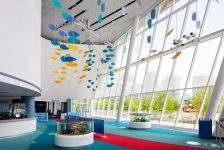David Rokeby and Michael Awad’s kinetic mobile, Schooling, seemingly transports visitors of Ripley’s Aquarium in Toronto underwater and into a massive aquarium tank where they can watch small fish swim through the air above their heads. Coloured in various shades of blue and yellow, the fish’s shiny, plasticky bodies glimmer and cast shadows as they shift in and out of the sunlight. Like an Alexander Calder piece taken over by robotics, this mobile’s conventional structure is animated by 62 motors which “represent the complex, unpredictable movement of fish as they group and scatter.”

Schooling

David Rokeby
b.1960
Micheal Awad
b.1966
- Aluminum, plastic, electronic motors, custom electronics, computer and custom software
- 2013
- Approx. 20 m x 10 m
- 288 Bremner Blvd, Ripley Aquarium, Toronto
About the artwork
About the artist
A prolific artist, architect, and academic, Michael Awad has truly left his mark upon the city of Toronto. He has taught at the University of Toronto School of Architecture for more than 10 years, and is a faculty member in the School of Urban Planning at Ryerson University. Working primarily with the medium of photography, Awad’s practice is unique to him as he builds his own camera equipment and creates his own image processing software. The “city” can be described as his principle and only subject.
Since 2005, Awad has partnered with fellow artist David Rokeby to create public art installations through sculptural forms. The pair has collaborated on works at the Ontario Science Centre, Union Square, and the Ripley’s Aquarium of Canada. Awad was the recipient of a Toronto Urban Design Award for his public artworks in 2011, and has participated in public art selection committees for all three levels of Canadian government. In serving as Chair of the Board of InterAccess, a centre dedicated to new media art in Toronto, Awad has been granted the opportunity to lend his experienced voice to the local arts community.
Awad’s photographic work has been shown in exhibitions at the The Power Plant Contemporary Art Gallery, the Art Gallery of Ontario, and the Royal Ontario Museum. In 2002, he was Canada’s official representative to the Venice Biennale of Architecture, and shortly thereafter, was commissioned to design the Canadian pavilion for the Visual Art Biennale of Brazil in São Paulo.
David Rokeby has been creating works of electronic, video, and installation art out of his studio in Toronto since 1982. While he initially focused on making interactive pieces that directly engaged with the human body, or that involved artificial perception systems, Rokeby has expanded his practice to include kinetic and static sculpture. In his art and essays, Rokeby explores the “social, political, and psychological challenges posed by emerging technologies, and conversely, how these can be used to expand the dialogue about what it means to be human in our contemporary world.”
Rokeby has performed and exhibited in shows across North America, Europe, and Asia. His early piece, Very Nervous System, presented at the Venice Biennale in 1986, is still acknowledged as a pioneering work of interactive art. Examining the human relationship with digital machines, the piece translated physical gestures into real-time, interactive sound environments.
Rokeby has been awarded with the first BAFTA (British Academy of Film and Television Arts) for Interactive Art in 2000, a 2002 Governor General’s award in Visual and Media Arts, and the Prix Ars Electronica Golden Nica for Interactive Art in 2002.
Fun facts
- David Rokeby has expanded his creative skillset to include computer programming, and has even coined a phrase that is familiar to artists working with "dataveillance" (i.e. the practice of monitoring digital data relating to personal details or online activities). Algorithmic pollution suggests "the importance of invisible information as matter that effects public behaviour from both a physiological and psychological view".
- Michael Awad was commissioned to create a version of his Entire City Project for the Royal Ontario Museum. Capturing multiple panoramas of the space, Awad describes his pieces as an attempt to visualize "the totality of the environment." The sheer amount of detail within the photographs can easily overwhelm anyone who tries to take a closer look.
Engagement questions
- In your opinion, how does this work transform the space around it?
